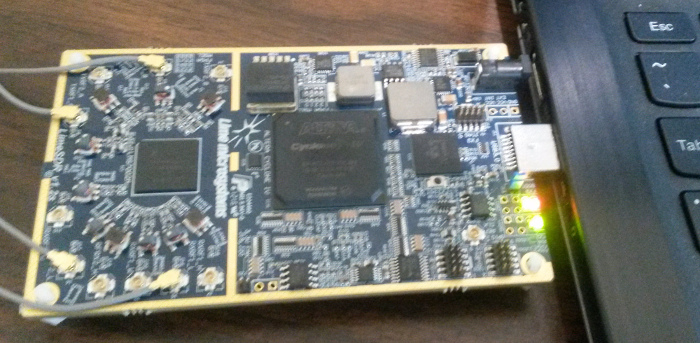LimeSDR - on the crowd funding campaign trail Thu, May 19 2016 AM
I'm on the campaign for the new LimeSDR - a MIMO capable SDR based around the FX3 and the new Lime LMS7002M RFIC. Its my first time being a part of crowd funded project and quite exciting. My role is to support the LimeSuite software, make sure that LimeSDR is well supported under SoapySDR, and to provide some example demonstrations using SoapySDR and Pothos.

Lime SDR blogs
I will be periodically blogging over at myriadrf during the campaign. My first post is on the driver architecture, but stay tuned for more application demos.
- Lime Suite driver architecture blog
- Lime Suite build and install guide
- LimeSDR application ecosystem blog
- LimeSDR modem with Pothos LoRa blocks
Lime Suite development
Lime Suite is the driver for the LimeSDR, but its also an API for working with the LMS7002M, and a gateway for custom board developments. My Lime Suite developments focus on generalizing the connection interface and to make it extensible for new devices, adding SoapySDR support, and improving the cmake build process.
Besides the general driver stuff, I have been working with LimeSDR hardware quite a bit to ensure that it works well with the SDR ecosystem. This includes making sure that the SoapySDR hooks work correctly, performance work and caching for some of the underlying driver calls, and ensuring that advanced time and burst stream controls work as expected.
Lime Suite packaging
I have taken care of the usual OS support for windows, ubuntu, and osx. Its hard to package for everything, but this should cover most users.
- Announcement about the drivers PPA for ubuntu.
- Its now part of the PothosSDR windows installer.
- And there is now a homebrew recipe for limesdr.
The Lime SDR hardware
LimeSDR is an exciting piece of hardware given its features and price point. Its a dual channel (MIMO) transceiver with a very wide tunable range (up to 3.8GHz), and configurable clocking as well which means arbitrary sample rate support. Each pair of Tx and Rx channels can be independently tuned as there is a dedicated LO for each direction. The stock FPGA image supports timestamped streams for implementing real world communication protocols, but it also opens the door to computational offload tasks for certain applications.
The acrylic case option
Pictured above is the LimeSDR (usb mini B connector) in the acrylic case. The case is based on stacked laser-cut layers of acrylic. So it feels solid and I like how snugly it holds the USB cable. Notice the first image on this blog has the USB male connector. It was pretty novel to plug the LimeSDR directly into the PC, though I think most will want the mini version of the connector.
